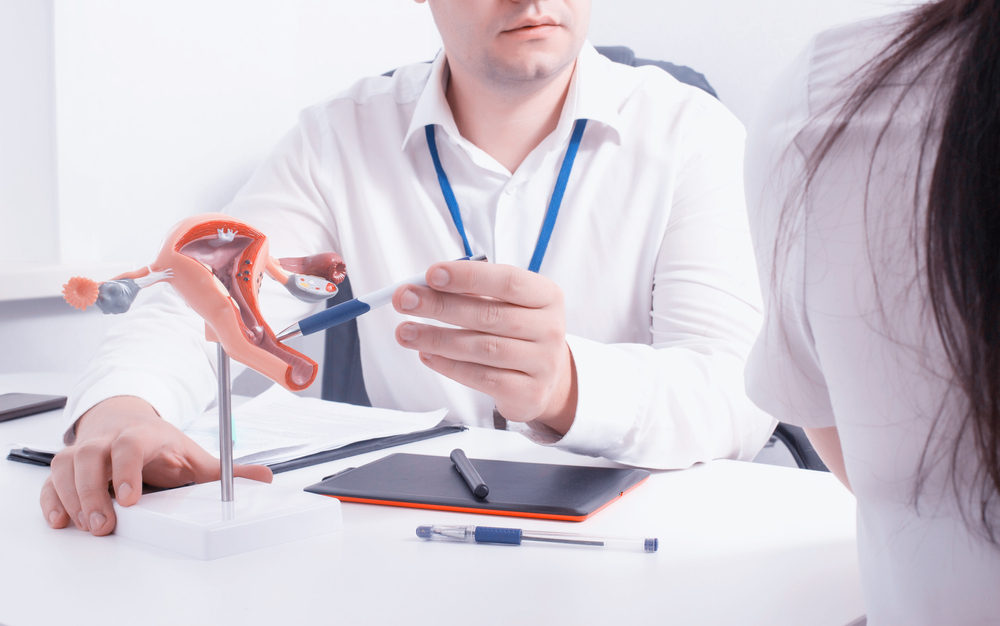A submucosal fibroid is a benign growth in the uterus’s inner layer which impacts numerous women’s health and fertility. Through this comprehensive guide, we aim to demystify submucosal fibroids by exploring their causes, symptoms, and various treatment options.
If you identify with the symptoms described, our team at Broward Complete OB-GYN Wellness Center is ready to assist. Our experts are committed to answering your questions and guiding you through the process of treating submucosal fibroids.
If you’ve been diagnosed and you are looking for the best submucosal fibroids treatment, don’t hesitate and consider Gynecologic Surgery in Plantation, Florida.
So, what is a submucosal fibroid? What is the best submucosal fibroid treatment you can get? Keep reading to find out.
What is a Submucosal Fibroid and How Serious Is It?
Understanding fibroids requires acknowledging that these uterine growths come in three primary types: subserosal, intramural, and submucosal fibroids.
Each differs in location, frequency, and potential complications they may bring.
- Subserosal Fibroids: These fibroids develop on the outer wall of the uterus and are the most common type. Typically, they cause symptoms when they grow large enough to press on other organs.
- Intramural Fibroids: As the most common type of fibroids, intramural fibroids grow within the muscular uterine wall. They can distort the uterus, leading to prolonged, heavy periods and pelvic pressure or pain.
- Submucosal Fibroids: These are the rarest type and the topic of this guide.
A submucosal fibroid nestles just under the uterine lining, i.e., the endometrium. While these fibroids may be rare, they are not to be overlooked due to the complications they can cause.
Although submucosal fibroids are benign, meaning they are not cancerous, their impact on your health can be significant. Heavy bleeding caused by these fibroids can lead to conditions like anemia, which is a concern for overall health.
This also brings us to their size.
Namely, submucosal fibroids vary greatly in size. They can be as petite as 0.4 inches or expand to a substantial length of up to 9 inches. In extreme cases, a single fibroid can grow as large as a watermelon.
It’s crucial to underscore that submucosal fibroids can dramatically affect everyday life. Their presence can lead to significant discomfort and, most notably, impact fertility.
Understanding these facts is critical to recognizing symptoms early and seeking timely and appropriate treatment.
As you see, submucosal uterine fibroids are a severe condition. If you or a loved one are worried about submucosal uterine fibroids, consult with our expert team at Broward Complete OB-GYN Wellness Center.
We are here to help answer questions such as “What is a submucosal fibroid?”, “What are the best treatment options available?” and more.
With this in mind, if you are in the area or you are looking for the best treatment possible, Gynecologic Surgery in Plantation, Florida, is your go-to choice.
Key Symptoms of Submucosal Uterine Fibroids

Submucosal myomas, or fibroids, often present a specific set of symptoms. Some of the most common symptoms include:
- Heavy Menstrual Bleeding: This is typically the most noticeable sign of submucosal myomas, with some women experiencing soaking through pads or tampons within an hour.
- Prolonged Menstrual Cycles: Periods may last longer than a week, again due to the presence of these fibroids.
- Pelvic Pressure or Pain: As the myomas grow, they may exert pressure on the surrounding areas, leading to discomfort or pain.
- Frequent Urination: Large fibroids can press on the bladder, increasing the urge to urinate.
There are also some less common but important symptoms to be aware of, such as:
- Difficulty Emptying the Bladder: In some cases, fibroids can obstruct the passage of urine, causing difficulty in fully emptying the bladder.
- Constipation: In rare cases, if the fibroids are large enough, they may press on the rectum, leading to constipation.
Also, according to experts, submucosal leiomyomas are a key contributor to abnormal menstrual bleeding. Their position just under the lining of the uterus can cause disruptions to the menstrual cycle, leading to heavy and extended periods.
Upon noticing these symptoms, it’s essential to seek professional medical advice.
Consulting with a trusted healthcare provider such as Broward Complete OB-GYN Wellness Center ensures you get the most accurate diagnosis and treatment options tailored to your condition.
As we’ve mentioned earlier, our experienced team can guide you through the process and address any concerns or questions that you may have regarding submucosal myomas.
Main Causes of Submucosal Leiomyomas to Keep In Mind
The causes of submucosal leiomyomas or fibroids are multifactorial, often influenced by genetic, hormonal, and lifestyle factors. While the exact cause remains unclear, several key contributing factors have been identified:
- Age: The risk of developing submucosal leiomyomas tends to increase with age, particularly during a woman’s childbearing years.
- Ethnic Background: There is a marked disparity in the prevalence of fibroids, with members of the Black community being three times more likely to develop submucosal leiomyomas than other ethnic groups.
- Family History: If a close family member has experienced uterine fibroids, there is a threefold increase in the likelihood that they may develop this condition.
- Weight: Being overweight or obese increases the risk of fibroids. Excess fat tissue can increase estrogen levels, a hormone linked to the growth of fibroids.
- Hormonal Balance: Estrogen and progesterone, two hormones involved in the menstrual cycle, seem to promote the growth of fibroids.
- Previous Pregnancies: Having been pregnant before appears to decrease the risk of developing fibroids, though the reasons for this are still under investigation.
- Diet: Diet plays a role in fibroid development. Consuming more fruits and vegetables, especially citrus fruits and foods high in Vitamin D, along with dairy products, may help prevent fibroid growth.
Awareness of these factors enables us to make proactive decisions about our health and lifestyle to mitigate the risk of developing submucosal leiomyomas.
It’s important to note that having one or more risk factors does not guarantee the development of fibroids, just as being devoid of these factors doesn’t eliminate the risk entirely.
The role of these factors is to guide us toward better health decisions and encourage regular health check-ups.
Diagnosing a Submucosal Myoma: What Experts Say
Can you self-diagnose a submucosal fibroid based on the mentioned symptoms?
No, diagnosing submucosal myomas or fibroids is a task for medical professionals. While you can recognize the potential symptoms described in this guide, it’s important to consult a healthcare provider for an accurate diagnosis.
Self-diagnosis based on symptoms alone can lead to inaccurate conclusions, as many other conditions share similar symptoms with fibroids.
Fortunately, several diagnostic tools are available for accurately identifying submucosal myomas:
- Ultrasound: This non-invasive test uses sound waves to create an image of the uterus, enabling the detection of fibroids.
- X-rays: While not commonly used for diagnosing fibroids, X-rays can sometimes reveal abnormalities that suggest the presence of fibroids.
- MRI (Magnetic Resonance Imaging): An MRI provides a detailed image of the uterus, allowing the identification of fibroids and their type and size.
- CT Scan (Computed Tomography): CT scans provide cross-sectional images of the body, offering another way to detect fibroids, although they are not typically the first choice for fibroid detection.
- Hysterosalpingogram: This specific type of X-ray involves injecting a dye into the uterus and fallopian tubes, providing a clear image of the uterine cavity to detect fibroids.
- Sonohysterogram: This test involves injecting fluid into the uterus via the cervix, then performing an ultrasound. The fluid helps provide a clear image of any fibroids within the uterine cavity.
Aside from these imaging tests, doctors may recommend minimally invasive procedures to confirm the diagnosis:
- Hysteroscopy: A small, lighted telescope called a hysteroscope is inserted into the uterus through the vagina and cervix, allowing the doctor to see and examine the uterus’s interior.
- Laparoscopy: In this procedure, a laparoscope (a thin tube with a camera on the end) is inserted through a small incision in the abdomen, providing a view of the outside of the uterus and allowing the doctor to detect any fibroids.
These diagnostic tools offer an accurate way to detect submucosal myomas and, in turn, allow medical professionals to provide the best treatment plan tailored to each individual’s situation.
Submucosal Fibroids and Common Complications
By now, you are aware that submucosal myomas, while not cancerous, can lead to various complications if left untreated. It’s crucial to understand the potential impacts on health and lifestyle:
- C-Section Delivery: Women with fibroids are more likely to have a C-section delivery due to concerns about labor progression and the baby’s position.
- Miscarriage and Preterm Birth: Fibroids, specifically submucosal types, can increase the risk of miscarriage and preterm birth due to their location within the uterus.
- Anemia: Heavy menstrual bleeding, a common symptom of submucosal fibroids, can lead to iron-deficiency anemia.
- Infertility: Fibroids can cause fertility problems by altering the shape of the cervix, changing the shape of the uterus, or obstructing the fallopian tubes.
- Postpartum Hemorrhage: Women with fibroids are at a higher risk of heavy bleeding after childbirth.
- Kidney Issues: Large fibroids can press on the kidneys, leading to renal complications.
- Urinary Tract Infections: Pressure from fibroids can affect bladder function, leading to urinary issues and potential infections.
- Placenta Previa: The presence of fibroids can interfere with the implantation of the placenta in the uterus, leading to a condition called placenta previa.
Whether or not to have a fibroid removed depends on various factors, including the size of the fibroid, its location, whether it’s causing symptoms, and the patient’s overall health and future family plans.
While many fibroids do not need to be removed if they’re not causing symptoms, it’s essential to consult a healthcare provider to make an informed decision.
What happens if you don’t get the proper treatment?
If left untreated, submucosal fibroids may continue to grow and potentially exacerbate the mentioned complications.
Regular monitoring and consultation with a healthcare provider are vital to managing fibroids effectively.
The Best Submucosal Fibroids Treatment: Your Options

The best submucosal fibroids treatment aims to achieve five key objectives:
- Decrease in Pain Levels
- Reduction in Heavy Menstruation
- Decreased Cramping
- Improvement and Preservation of Fertility
- Improvements in Other Body Systems
The optimal submucosal fibroids treatment approach will depend on factors such as your age, overall health, the severity of your symptoms, and future family planning.
Some potential approaches to treating submucosal fibroids include:
- Observation: Since fibroids are noncancerous and don’t always cause significant symptoms, doctors may suggest a “wait and see” approach, monitoring fibroids for changes over time.
- Myomectomy: Myomectomy is a surgical procedure specifically designed to remove uterine fibroids, also known as myomas.
Unlike a hysterectomy, which involves the removal of the entire uterus, myomectomy only removes the fibroids, leaving the uterus intact.
This makes it a preferred option for women who wish to become pregnant in the future or want to keep their uterus for other reasons.
There are three main types of myomectomy, and the choice of procedure typically depends on the size, location, and number of fibroids:
- Abdominal Myomectomy: Also known as an open myomectomy, this procedure involves making a large incision in the abdomen to access the uterus and remove fibroids. It is typically used for larger fibroids or when there are numerous fibroids to remove.
- Laparoscopic Myomectomy: This is a minimally invasive procedure where small incisions are made in the abdomen, and the surgeon uses a laparoscope (a thin tube with a camera) and specialized surgical instruments to remove the fibroids.
- Hysteroscopic Myomectomy: This procedure is typically used for submucosal fibroids that are located within or bulging into the uterine cavity.
A hysteroscope (a thin, telescope-like instrument) is inserted through the vagina and cervix into the uterus, allowing the surgeon to see and remove the fibroids.
- Hysterectomy: This involves the complete removal of the uterus. In some cases, the ovaries and fallopian tubes may also be removed.
There are two types of hysterectomies – total (removing the entire uterus and cervix) and subtotal (removing only the uterus).
This option is typically recommended for women with severe symptoms who are not planning to become pregnant in the future.
There are several types of hysterectomies, and the choice depends on the patient’s condition and the extent of the fibroids:
- Total Hysterectomy: The entire uterus, including the cervix, is removed. This is the most common type of hysterectomy.
- Subtotal or Partial Hysterectomy: The upper part of the uterus is removed while the cervix is left in place. This is typically performed when there are no fibroids in the cervix or when the patient prefers to keep it.
- Radical Hysterectomy: The uterus, cervix, the upper part of the vagina, and nearby tissues are removed. This type is usually reserved for certain types of cancer and is not typically used for fibroids.
- Uterine Fibroid Embolization (UFE): This treatment involves blocking the blood supply to the fibroids, causing them to shrink.
It’s typically an option for women with moderate to severe symptoms who don’t want surgery or are not good candidates for surgery.
Additional treatment options include:
- Endometrial Ablation: The removal or destruction of the lining of the uterus.
Endometrial ablation is a procedure that surgically destroys (ablates) the lining of the uterus, known as the endometrium.
This procedure is generally used to treat abnormal uterine bleeding, but it can also be effective for treating submucosal fibroids that are close to or protruding into the uterine cavity.
Endometrial ablation is less invasive than a hysterectomy or myomectomy and has a shorter recovery time.
However, it’s important to note that endometrial ablation often reduces fertility and is not recommended for women who wish to have children in the future.
The procedure is performed using a variety of methods, including heat, electricity, freezing, microwaves, or radiofrequency energy.
- MRgFUS (Magnetic Resonance-guided Focused Ultrasound Surgery): A non-invasive procedure that uses high-frequency sound waves to heat and destroy fibroids.
- Ultrasound-Guided Radiofrequency Ablation: A minimally invasive procedure using radiofrequency energy to destroy fibroids.
- Certain medications can also be prescribed to manage symptoms, though they don’t cure the fibroids. These may include progesterone injections, over-the-counter pain relievers, and hormonal therapies.
Self-care measures can also help manage symptoms. These may include:
- Using heating pads for pain relief
- Taking warm baths to relax muscles
- Practicing relaxation techniques like meditation or yoga
- Engaging in light physical exercise
Remember, while each of these treatment options has its benefits and risks, the best choice will always be the one tailored to your specific needs and circumstances. As always, consult with a healthcare professional before deciding on a treatment plan.
Give Us a Call Today
Take care of your health and the well-being of your entire family. Schedule an appointment with Broward Complete OB-GYN Wellness Center to get started!


